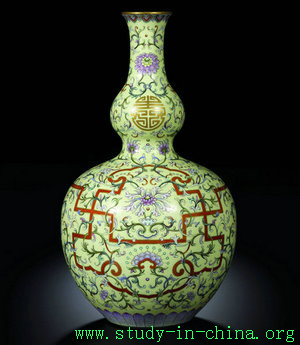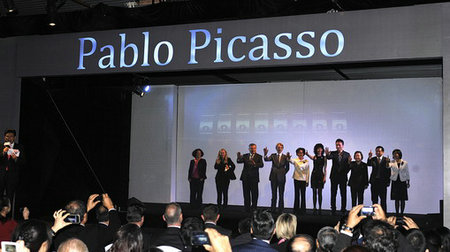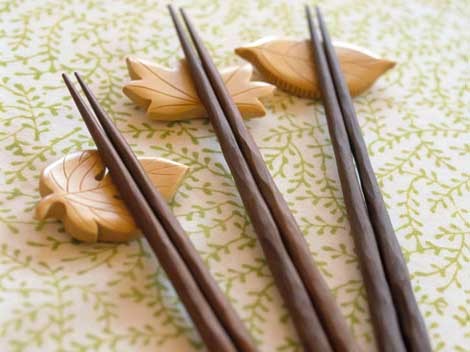| Home > China Feature |
Ming Dynasty Vase Breaks Auction Record at Sotheby's

An Outstanding Blue and White Vase with Fruit Sprays, Meiping
Ming Dynasty, Yongle Period
Estimate: HK$80 - 120 million / US$10.3 - 15.4 million
Height: 36.5 cm.
Meiping decorated with fruit sprays are well known from the Yongle period. This large Yongle period meiping, with its elaborate decoration of ten fruit sprays, most likely predates the well-known smaller vases of this form. Only one companion piece to the present vase appears to be recorded, a covered meiping in the Palace Museum, Beijing. The present vase supplies vivid testimony to the success of these undertakings - its rich repertoire of fruit and flower motifs make it a masterpiece of Yongle porcelain art.
A prominent old world collection of imperial ceramics fetched $72 million at a Sotheby's Hong Kong sale on last wednesday, with an early Ming cobalt blue Meiping vase going for a record $21.6 million despite recent financial market turmoil.
The Meiyintang collection, a unique, respected assemblage of Chinese porcelain collected over nearly half a century by Swiss tycoons, the Zuellig brothers, was offered onto the market for the first time in April in a highly anticipated Hong Kong sale.
Some major lots, however, including a golden pheasant vase, failed to find buyers in an auction that saw aggressive estimates and tighter credit requirements weigh on sentiment.
The second part of the Meiyintang sale on Wednesday, however, with an emphasis on earlier, monochromatic Ming wares, saw a large auction hall bid steadily for the best of the 41 lots despite recent plunges in local and global stock markets.
The biannual Sotheby's sales are considered a key indicator of the Asian art market. While ceramics and classic Chinese paintings performed solidly, the Asian and Chinese contemporary art sales showed signs of strain, with unsold work ratios of over 20 percent as the global economic uncertainty deepens.
Whilst some major lots with conspicuous cracks failed to sell, bidding was strong for a sublime blue and white "meiping" vase of fruit sprays from the Ming Yongle period that went for HK$168.7 million ($21.6 million) to a telephone bidder, a world record at auction for any piece of Chinese Ming porcelain.
"The Ming was strong this time," said William Chak, a prominent Hong Kong dealer who bought a sky-blue Yongzheng gourd vase at the sale for HK$4.6 million.
A famille-rose Qing Qianlong period "peach" vase managed to fetch HK$90.3 million ($11.6 million) in another notable result, while another bright spot was the $3.7 million bid made for an extremely rare blue and white Ming Yongle period "Jue" stand.
Ming porcelain (1368-1644), older though often less decorative and ornate than Qing (1644-1911) wares, has in recent years been relatively less desired by nouveau riche Chinese mainland buyers, meaning its prices haven't reached anywhere near the heights of dazzling late Qing trophy pieces.
There was some weakness, though, in Sotheby's other ceramics and Chinese art work sale, with a batch of a so-called premium lots - that require hefty credit guarantees in order to bid - failing to sell.
This included a Qianlong era white "phoenix" vase as well as a cinnabar lacquer "dragon" bowl that had been expected to fetch tens of millions of Hong Kong dollars.
"I think many people were worried what would happen before the sales," said Nader Rasti, an Asian art dealer. "But I think they did well considering what's going on ... 15th century porcelain has been so cheap for so long, there's a lot of good Ming porcelain that's still undervalued."
The predominantly Chinese mainland buyers present on Wednesday, who've powered the Chinese ceramics market in recent years, weren't buying indiscriminately this time round, giving rare, though flawed pieces a wide berth.
22 percent of the Meiyintang wares went unsold including two premium lots: a Ming Yongle period moonflask whose cracked neck had been entirely rebuilt and a Qing Qianlong reign famille-rose gourd flask with cracks on its handles. ($1 = 7.786 Hong Kong Dollars)
A Qianlong period (c.1740) Imperial yang cai reticulated double-walled vase with six-character reign mark has became the most expensive Chinese work of art ever to sell at auction anywhere in the world. It sold for £51.6m ($83m) at Bainbridge’s Auctions, in the west London suburb of Ruislip, to an anonymous Chinese buyer in the room. It is not yet known whether he represented a mainland Chinese institution or private buyer. The price beat the previous record of RMB436.8m ($65.95m) set at Beijing Poly in June 2010 for a Song Dynasty scroll by Huang Tingjian (1045-1105).
The vase was discovered during a routine valuation at a house in the London satellite town of Pinner. Its owners had inherited it from a relative, who they believe acquired it in the 1930s. “They had no idea what it was, but we could see that it was good—we gradually realized how special it was when our expert cataloguer began to do some research”, said Jane Bainbridge, co-partner in the auction house.
The estimate was set at £800,000-£1.2m, but rumours began to circulate that it could reach the £15m mark after an advert was posted in the British trade newspaper Antiques Trade Gazette two weeks ago. It was timed to tie in with the annual Asian Art in London sales and exhibitions. “People began to phone us up from all over the world after that”, said Bainbridge.
The auction room was full, with many Chinese buyers in attendance and more on the telephones. As the price climbed to £15m the auctioneers stayed calm as the increments continued to rise. “We all behaved exactly as we do at any sale, but the room got very excited—we had a round of applause when bidding reached the £40 million mark”.
The term yang cai translates as “foreign colours” and refers to the palette of enamels that were introduced from Europe around 1685, and later became associated with the famille rose export wares.
The 16-inch (40.5cm) high vase is of ovoid form with celadon glazed pierced body of interlocking chilong, through which could be seen the inner body of Ming style blue and white scrolling flowers. Four medallions around the body are decorated with varied pairs of fish set against modelled and carved waves.
Alice Cheng remembers a Chinese vase that sat in the house of one of her father’s friends when she was a little girl. Last year she bought it at a sale in Hong Kong for HK$252.7 million ($32.6 million).
Cheng, a collector and sister of Hong Kong dealer Robert Chang, paid more than five times the top estimate for the famille-rose double-gourd vase, with the seal mark of the art- loving Qianlong Emperor (1736-1795), helping push Sotheby’s autumn sale total to a record HK$3.09 billion.
“I knew the price was going to be high, but as long as I like it, it’s worth it,” said Cheng, wearing a pair of red sapphire earrings, after the sale. “I like it a lot.”
The weeklong sale by New York-based Sotheby’s at the Hong Kong Convention and Exhibition Centre, covering wine, modern and contemporary art, traditional Chinese paintings, watches, jewelry and antiques helps indicate to collectors and dealers the strength of demand for art and luxury goods in Asia. The final total was more than 50 percent higher than the company’s previous record in the city of HK$2 billion set in April.
Shanghai-born Cheng, 78, who is a director of Chinese companies in oil, communications and transport, has raised the bar for Chinese ceramics before. In May 2002, she paid HK$41.5 million for an enameled vase from the reign of Emperor Yongzheng (1723-1735) at Sotheby’s in Hong Kong, a record at the time for a Qing ceramic. She donated it to the Shanghai Museum, she said. Four years later she paid a then-record HK$151.3 million for a Qing porcelain bowl being sold by her brother at a Christie’s International sale in the city.
Art
 more
moreThe 13th China Shanghai Internati...
On the evening in Shanghai, lights glittering warmly in front of n...

Beijing Traditional Music Festiva...
Enchanting sounds and melodies of Chinese instruments fascinated the...

13th Shanghai International Arts ...
The 13th China Shanghai International Arts Festival (CSIAF) kicks of...

Custom
 more
moreWeb Dictionary
Martial Arts
Wuxia, a Popular Culture for Most Chinese-Speaki...
Wuxia (武侠) is a broad genre of Chinese fiction that concerns its...
Bruce Lee
There’s a new biopic of martial arts expert Bruce Lee ahead of us....
Wudang Martial Arts
Wudang Wushu is one of the key schools of Chinese martial arts. ...





 print
print  email
email  Favorite
Favorite  Transtlate
Transtlate 







